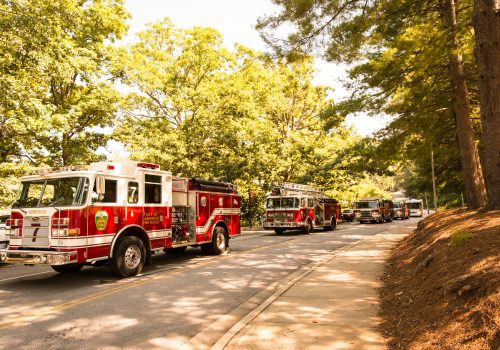Fire Alarms and Building Evacuation
When the fire alarm sounds:
- Ensure your safety and leave immediately. Evacuate the building via the nearest exist. Do not waste critical time in leaving.
- If possible, render assistance to others, especially those who have functional needs.
- Try to get to the pre-selected meeting area for your building.
- Feel the doors before opening. If the door is hot, do not open the door. If it is cool, open it slightly, and if heat or heavy smoke are present, close the door and stay in the room. Go to the nearest exit. Crawl if there is smoke.
- If the nearest exit is blocked by fire, heat, or smoke, try another exit. You may have to step in a room to escape fire, heat, or smoke. Follow instructions for if you get trapped.
- Do not stop to investigate if the alarm is real or false. Evacuate immediately.
- Do not use an elevator during a fire emergency
- Do not re-enter the building for any reason until the all clear signal is given.
If you discover a fire, visible smoke, the odor of smoke, or evidence of fire, the fire alarm should be pulled and University Police (828.232.5000) called from a safe location. Do not pull the fire alarm in the event of a gas leak.
If you get trapped
- Keep the doors closed and place a cloth around and under the door to prevent smoke from entering
- Signal for help by hanging an object at the window (jacket/shirt/blanket) to attract the attention of others
- Call University Police at 828.232.5000 or 911 and give them your room number and location if possible
- If you are on fire: Stop, drop, and roll to smother the flames
Fire Classifications & Extinguishing Methods
If you have not been trained on extinguishing methods, or the fire is significant, do not try to extinguish it and call for assistance immediately. Dial 911 or call University Police at 828.232.5000. Using the incorrect extinguishing method may case the fire to spread rapidly.
- Wood, paper, textiles & rubber – ABC extinguisher can extinguish this type of fire
- Flammable or combustible liquids, greases, petroleum products, or solvents – Carbon dioxide or dry chemical ABC extinguishers should be used. Water should not be used as it may result in spreading the fire
- Live electrical equipment involved in a fire – If possible, turn off the power to the devices and then use either dry chemical or a carbon dioxide or halon extinguisher.
- Sodium, potassium, magnesium, titanium, zirconium and other metals (laboratory fires) – If sodium, potassium, magnesium, or any other flammable metal powders are to be used in a laboratory, call EH&S for guidance on the appropriate dry powder-extinguishing agent. A specific “Class D” (dry powder) extinguishing agent such as graphite, limestone, sand or sodium carbonate must be made available for fire emergency before work is started.
DO NOT USE pressurized water, carbon dioxide, dry chemical or halon extinguishers on metal or organometallic fires. The use of these extinguishers may introduce substances that are very reactive with the burning metal that may either make the fire grow or trigger an explosion.
